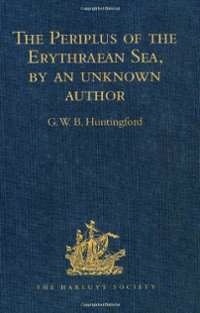 The anonymous author of Periplus Maris Erythraei (The Navigation of the Erythraean Sea aka Indian Ocean) is a 1st century AD, Greek-speaking Egyptian sea trader. In order to grasp more fully what an ancient writer has to say to us, we must imagine this Anonymous, perhaps bearded and middle-aged, in a casual white toga sitting at his wooden desk with his bronze stylus pen writing down carefully on papyrus his extensive knowledge of his ship Argos’ many trips out of Egypt, down the Red Sea across the Persian/Arabian Gulf into the Indian Ocean and landing finally in northern India. See him trading/bartering/selling his goods to the Indian businessmen there in the crowded ports and buying their Eastern goods to bring back to the Western world.
The anonymous author of Periplus Maris Erythraei (The Navigation of the Erythraean Sea aka Indian Ocean) is a 1st century AD, Greek-speaking Egyptian sea trader. In order to grasp more fully what an ancient writer has to say to us, we must imagine this Anonymous, perhaps bearded and middle-aged, in a casual white toga sitting at his wooden desk with his bronze stylus pen writing down carefully on papyrus his extensive knowledge of his ship Argos’ many trips out of Egypt, down the Red Sea across the Persian/Arabian Gulf into the Indian Ocean and landing finally in northern India. See him trading/bartering/selling his goods to the Indian businessmen there in the crowded ports and buying their Eastern goods to bring back to the Western world.
Imagine him in his ship counting his profit in, say, the port of Barygaza (in India near modern Karachi); and see him homeward bound after 8-10 months away from his family and his favorite chicken with plum sauce; and the joy he felt when he was finally stretched out in his own bed with the soft linen sheets. One imagines him the captain/owner of the ship from his many warnings about ocean dangers and his intricate directions on how to navigate into all foreign ports. One imagines he no longer takes those trips. As he writes, his mind and emotions are in India with all its fragrance.
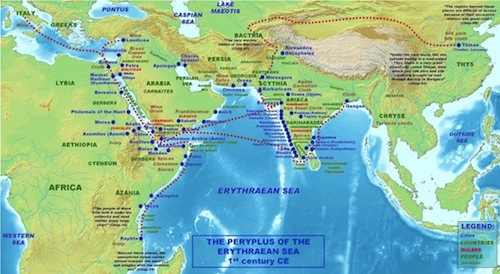
Anonymous has left a detailed account of his numerous trading voyages to and from India and all the goods imported to India and the commodities exported from India. This writer could not hope to address as well as he has the ancient world’s very robust commerce with India. We’ll let the 2,000-year-old Egyptian speak: ”Beyond these places, in a bay at the foot of the left side of this gulf (Red Sea), there is a place by the shore called Muza (port on the Red Sea), a market-town established by law, distant altogether from (Red Sea port town of) Berenice for those sailing southward, about twelve thousand stadia. And the whole of Muza is crowded with Arab ship-owners and seafaring men, and is busy with the affairs of commerce; for they carry on a trade with the far-side coast and with Barygaza (modern Indian city of Bharuch), sending their own ships there.” Anonymous, The Navigation of the Erythraean Sea 21
“….just beyond the cape projecting from this bay there is another market-town by the shore, Cana (trading port in Yemen)…the Frankincense Country….All the frankincense produced in the country is brought by camels to that place to be stored, and to Cana on rafts held up by inflated skins after the manner of the country, and in boats. And this place has a trade also with the far-side ports, with Barygaza (India) and Scythia (Iran) and Ommana (Oman) and the neighboring coast of Persia.” Ibid. 27
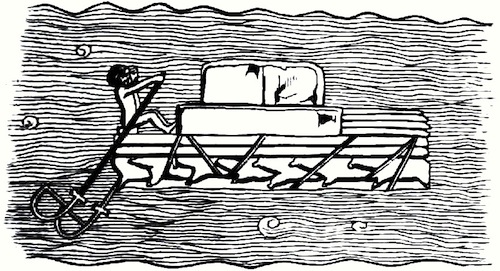

“Beyond Cana…and the Frankincense Country, mountainous and forbidding, wrapped in thick clouds and fog, and yielding frankincense from the trees. These incense-bearing trees are not of great height or thickness; they bear the frankincense sticking in drops on the bark, just as the trees among us in Egypt weep their gum. The frankincense is gathered by the King’s slaves and those who are sent to this service for punishment. For these places are very unhealthy, and pestilential even to those sailing along the coast, but almost always fatal to those working there, who also perish often from want of food.” Ibid. 29
“Trade is also carried on there by some people from Muza (mercantile port on Red Sea) and by those who chance to call there on the voyage from Damirica (on the Malabar coast of India)…they bring in (from India) rice and wheat and Indian cloth, and a few female slaves; and they take (from India to Europe) for their exchange cargoes a great quantity of tortoise-shell. Ibid. 31
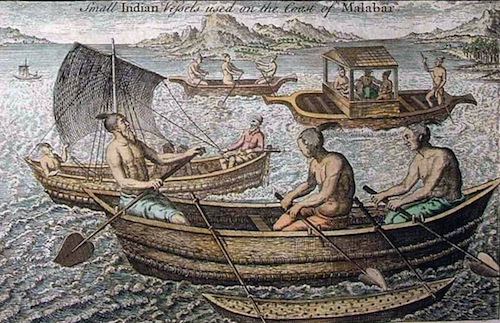
“…another market-town of Persia called Ommana. To both of these market-towns large vessels are regularly sent from Barygaza (India), loaded with copper and sandalwood and timbers of teakwood and logs of blackwood and ebony. To Ommana frankincense is also brought from Cana, and from Ommana to Arabia boats sewed together after the fashion of the place….From each of these market-towns, there are exported to Barygaza (India) and also to Arabia, many pearls, but inferior to those of India; purple, clothing after the fashion of the place, wine, a great quantity of dates, gold and slaves.” Ibid. 36
Note: The California Universal Church of Baba’s Kitchen in Santa Cruz, California has a fire ritual of blessings and healings. After the ritual, the entire group chants three times “Ommama,” probably a corruption of the name of the market-town in Persia where there were similar fire rituals so long ago.
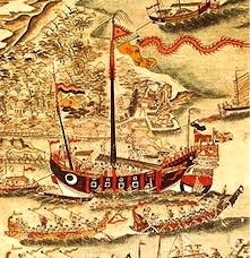
“The ships lie at anchor at Barbaricum (on the west coast of northern India), but all their cargoes are carried up to the metropolis by the river to the King. There are imported into this market a great deal of thin clothing, figured linens, topaz, coral, storax (a fragrant balsam), frankincense, vessels of glass, silver and gold plate, and a little wine. On the other hand there are exported costus (a spice from Kashmir), bdellium, lycium (a medicinal plant), nard, turquoise, lapis lazuli, Seric skins, cotton cloth, silk yarn, and indigo. And sailors set out thither with the Indian Etesian winds, about the month of July, that is Epiphi: it is more dangerous then, but through these winds the voyage is more direct, and sooner completed.” Ibid. 39

“Beyond the gulf of Baraca is the city of Barygaza and the coast of the country of Ariaca…and of all India….It is a fertile country, yielding wheat and rice and sesame oil and clarified butter (aka Ghee originated in India), cotton and the Indian cloths….of the coarser sorts. Very many cattle are pastured there, and the men are of great stature and black in color. The metropolis of this country is Minnagara (modern Karachi), from which much cotton cloth is brought down to Barygaza. In these places there remain even to the present time signs of the expedition of Alexander (the Great conquered India in 326 BC), such as ancient shrines, walls of forts and great wells.” Ibid. 41
Note: The writer calls “Barygaza on the (west) coast” the gateway “of all India.” Jesus’ Apostle Thomas, Doubting Thomas (John 20:24-29), went all the way to India to proclaim the Gospel. Most believe he sailed on a trading ship bound for the most important import/export center in India—Barygaza. Thomas spent about 40 years in India gaining converts to Christ from the west coast to the east coast where he was martyred c. 72 AD. In Chennai is St. Thomas Mount, the supposed place where Thomas was killed. Today there are about 25 million Christians in India.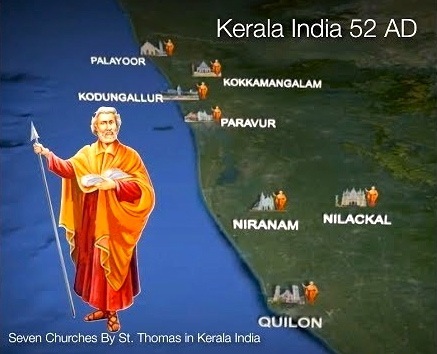
“This gulf is very narrow to Barygaza and very hard to navigate for those coming from the ocean; this is the case with both the right and left passages, but there is a better passage through the left. For on the right at the very mouth of the gulf there lies a shoal….opposite this on the left projects the promontory… and it is a bad anchorage because of the strong current setting in around it and because the anchors are cut off, the bottom being rough and rocky. And even if the entrance to the gulf is made safely, the mouth of the river at Barygaza is found with difficulty, because the shore is very low and cannot be made out until you are close upon it….Because of this, native fishermen in the King’s service, stationed at the very entrance in well-manned large boats go up the coast as far as Syrastrene (modern Saurashtra), from which they pilot vessels to Barygaza. And they steer them straight from the mouth of the bay between the shoals with their crews; and they tow them to fixed stations, going up with the beginning of the flood, and lying through the ebb at anchorages and in basins.” Ibid. 43-44
Note: This is a true captain of the ship remembering every detail of his ship’s maneuvering and maritime difficulties near the great trading center of India, Barygaza.

“Inland from this place and to the east, is the city called Ozene (now Ujjain, India)…from this place are brought down all things needed for the welfare of the country about Barygaza, and many things for our trade: agate and carnelian, Indian muslins and mallow cloth, and much ordinary cloth (obviously goods he could sell to the Egyptians and Romans on his return). Through this same region and from the upper country is brought the spikenard (the rhizomes were used as part of an herbal tradition in India and highly sought after in Egypt and Rome as a key ingredient in their most expensive perfume called nardinium).” Ibid. 47

Note: In the #47 chapter above is, also, this sentence: “The country inland of Barygaza is inhabited by numerous tribes…the people of Poclais, in which is Bucephalus Alexandria.” Bucephalus was Alexander the Great’s white warhorse he had tamed and trained when he was a boy. Bucephalus took the conquering young Alexander from Greece all the way to India and he fought riding Bucephalus in all the battles it took to subdue the then known world. Bucephalus was fatally wounded at age 30 at the Battle of Hydaspes in June 326 BC. Alexander was inconsolable after the horses’s death and named a city after him, Bucephalus Alexandria, which was still called by that name c. 400 years later in the first century AD when Anonymous mentioned it in his reminiscences.

“There are imported into this market-town (Barygaza) storax, wine, Italian preferred, also Laodicean and Arabian; copper, tin, and lead; coral and topaz; thin clothing and inferior sorts of all kinds; bright-colored girdles a cubit wide; storax, sweet clover, flint glass, realgar (a semi-precious red/orange mineral), antimony, gold and silver coin, on which there is a profit when exchanged for the money of the country; and ointment, but not very costly and not much. And for the King there are brought into those places very costly vessels of silver, singing boys, beautiful maidens for the harem, fine wines, thin clothing of the finest weaves, and the choicest ointments. There are exported from these places spikenard, costus (a type of ginger), bdellium, ivory, agate and carnelian, lycium (a medicinal plant prized by the ancients for fertility, sore eyes, etc.), cotton cloth of all kinds, silk cloth, mallow cloth (woven from the stalk of the mallow plant), yarn, pepper and such other things as are brought here from the various market-towns. Those bound for this market-town from Egypt (as the writer was) make the voyage favorably about the month of July (because they will avoid the monsoon season in India).” Ibid. 49
“This whole voyage (to India) as above described, from Cana and Eudaemon Arabia, they used to make in small vessels, sailing close around the shores of the gulfs; and Hippalus was the pilot who by observing the location of the ports and the conditions of the sea, first discovered how to lay his course straight across the (Indian) ocean. For at the same time when with us the Etesian winds are blowing, on the shores of India the wind sets in from the ocean, and this southwest wind is called Hippalus, from the name of him who first discovered the passage across (the Indian Ocean). From that time to the present day ships start, some direct from Cana, and some from the Cape of Spices (Somalia); and those bound for Damirica (Indian port) throw the ship’s head considerably off the wind; while those bound for Barygaza and Scythia keep along shore not more than three days and for the rest of the time hold the same course straight out to sea from that region, with a favorable wind, quite away from the land, and so sail outside past the aforesaid gulfs.” The Navigation of the Erythraean Sea 57
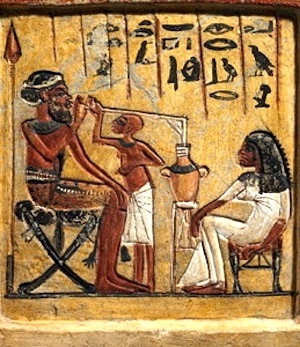
Note: Hippalus was a Greek navigator and merchant in the 1st century BC. The Egyptian writer of The Navigation of the Erythraean Sea gives the sea trader Hippalus who lived 100 years before he did the credit for not only discovering and defining the direct sea route from Egypt to India but for alerting him and other seafarers to the dangers they faced and the ports they needed to find. We do not have any writings by Hippalus, but the anonymous writer of Periplus Maris Erythraei has made sure Hippalus gets the credit for the fact he is home safe and sound in his study in Egypt with pen and papyrus in hand contented to be sipping beer and eating crusty bread.—Article by Sandra Sweeny Silver


